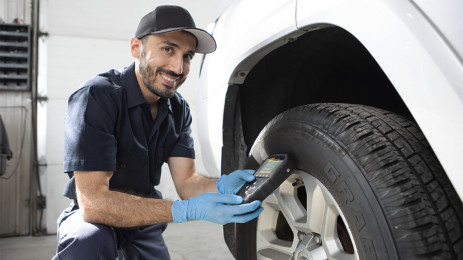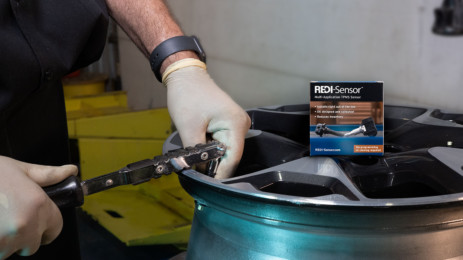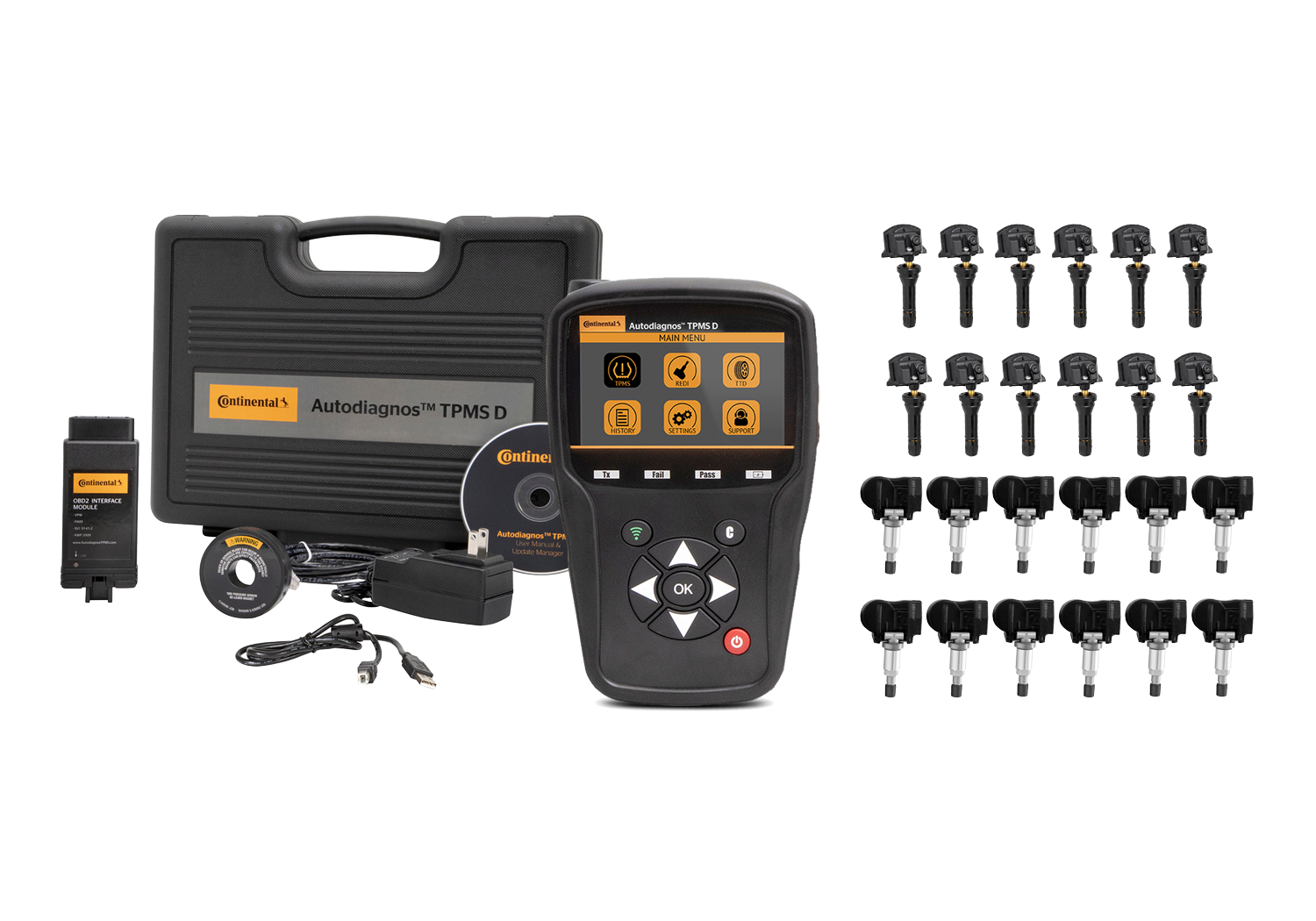TPMS Service Tips for Auto Service Professionals
In addition to technical challenges around TPMS sensor service, shops need to manage TPMS inventory, deal with parts proliferation, and provide training on TPMS service for their personnel.
At Continental, we develop Tire Pressure Monitoring Systems for OEMs as well as replacement sensors and service parts for the automotive aftermarket. We want to help ensure that drivers can count on their TPMS systems to deliver the safety assurance that they were designed to provide. That’s why we offer these TPMS service tips and Frequently Asked Questions for auto service professionals.
- TPMS Relearn vs TPMS Programming
TPMS Relearn vs TPMS Programming
Even among experienced service pros, there are still a lot of questions about TPMS service. One of the most common questions we hear is “what is the difference between TPMS relearn and TPMS programming.” Here’s the answer:
TPMS sensor programming is an extra TPMS service step
TPMS vehicle relearn and TPMS sensor programming are completely different procedures. Aftermarket TPMS sensors that come as “programmable,” “universal” or “clone-able” must be programmed with the proper protocol/application information for the specific vehicle before they can be installed. Once they have been successfully programmed, they must then be relearned to the vehicle.
In order to be able to program programmable sensors, technicians may need to invest in specialized tools, training, and software. In addition, these programming tools will periodically need to be updated to provide the latest application and software in order to work with the newest vehicles.
Multi-application sensors are pre-programmed
Multi-application TPMS sensors, such as REDI-Sensor, do not require this extra programming step, because they come out of the box with the proper programming needed to function with multiple vehicles’ TPMS. Because they are pre-programmed, REDI-Sensor Multi-Application TPMS Sensors, eliminate the time spent on programming and trouble-shooting programming and cloning issues. This helps make TPMS service more profitable and reduces customer complaints and comebacks.
Vehicle relearn is always a required TPMS service step
Regardless of whether it is an OE sensor, a programable sensor, or a multi-application sensor, every aftermarket TPMS sensor must be ‘relearned’ to the vehicle. The relearn procedure not only connects the sensor to the vehicle TPM System, it also provides a check that verifies the vehicle’s TPM System is functioning properly. With the exception of some Chrysler and Mazda models that may be relearned to the vehicle through a driving procedure, a TPMS scan tool is required to complete the vehicle relearn procedure.
Ready to use out of the box
VDO REDI-Sensor is a multi-application TPMS sensor that works exactly like the OE sensor. It is pre-programmed and ready for the vehicle relearn procedure as soon as you take it out of the box. REDI-Sensor follows the standard OE vehicles relearn procedures, and works with most major TPMS scan tools, including those from Continental, ATEQ, Bartec, OTC / SPX, K-Tool (T.I.P.S.) and Snap-on.
- How to speed up TPMS work
How to speed up TPMS work
The easiest way to speed up TPMS work in your shop is eliminate the need to call your supplier and wait for a TPMS sensor delivery. By keeping the four REDI-Sensors Multi-Application TPMS Sensors on hand, you’ll be ready to get to work on most every vehicle that comes into your shop. Instead of waiting for a parts delivery, or spending time programming a ‘universal’ sensor, you can get right to work on your customer’s vehicle.
Ready to use, right out of the box
REDI-Sensor is ready to use right out of the box. It does not require TPMS programming, and it relearns to the vehicle using the same process as with the OE sensor.
To be ready to service the majority of your customers with OE sensors, you would need to keep dozens of different sensors on hand. To be ready for your customers with REDI-Sensor, you just need a handful.
Why would I need dozens of OE sensors?
A lack of standardization and a wide variety of OE and aftermarket TPMS sensors on the market have caused tremendous TPMS parts proliferation. Many of these sensors require distinct RF protocols and use unique modes of operation. Parts stores have struggled to keep up with the huge number of TPMS sensors now on the market.
Some manufacturers have tried to address the TPMS sensor parts proliferation with ‘universal’ sensors that are supplied as blanks and need to be programmed before they are installed. For technicians, this means they may need to buy specialized tools to do the programing. In addition, they’ll have to periodically download and install software updates as new vehicle models are released. These programmable sensors may require technicians to learn specialized sensor relearn procedures, different from the OE procedures. Many of the TPMS service issues experienced by shops today are caused by problems with programming these ‘universal’ sensors.
Avoid TPMS sensor programming delays
REDI-Sensor needs no programming so there’s never any programming hang-ups. REDI-Sensor is a true multi-application TPMS sensor and each REDI-Sensor can be used on a variety of makes and models. REDI-Sensor works with all major scan tools, so you don’t have to purchase additional scan tools and software upgrades or undergo special training. If your scan tool is from Continental, Bartec, OTC, ATEQ, or T.I.P.S., you’re ready for REDI-Sensor.
- When do I need to replace TPMS sensor service parts?
When do I need to replace TPMS sensor service parts?
TPMS sensor service kit parts need to be replaced during every tire service including service work for flat tire repair and when mounting new tires. Even when a full sensor replacement is unnecessary, the service parts should be replaced.
- What’s included in the service parts?
What’s included in the service parts?
For sensors with a metal stem, the service kit generally consists of a hex nut, grommet/seal, valve core, and cap. For sensors with a rubber stem, the kit includes a complete new stem, core, and cap.
- Why do I need to replace the TPMS sensor service parts?
Why do I need to replace the TPMS sensor service parts?
Before the introduction of TPMS, a tire valve was a simple part. Either it held air or it didn’t, and if it didn’t you replaced it. Now, with TPMS, the valve assembly is an integral part of an essential safety system that’s been mandated by Federal law. If the valve assembly is compromised, so is the entire Tire Pressure Monitoring System.
Service parts can corrode and lose proper functionality over time. Replacing the TPMS service parts is needed to ensure you’re returning the vehicle to the customer with the tire safety system operating as designed.
- TPMS sensor service best practices:
TPMS sensor service best practices:
- Use only TPMS-specific service kit parts. Never use a standard brass valve core in a TPMS sensor!
- Always use new TPMS service kit parts. Never reuse service parts that have been previously installed.
- Always use a torque tool to tighten sensor hex nuts or other threaded TPMS components to proper specifications.
- TPMS sensors only need to be replaced if they’ve been damaged, or if the battery is worn out.
- Always check the spare tire to determine if it’s TPMS-equipped and working properly.
- Replacement TPMS sensors must be relearned to the vehicle, plus a relearn may also be required after performing a tire rotation.
- When doing any type of work that uncovers a control unit or wiring, carefully seal the components to protect from any type of moisture or chemical contact. If they are not protected, problems can arise with the TPMS sensors, including inaccurate pressure readings.
- TPMS Sensor Types
TPMS Sensor Types
There are several types available for service on today’s vehicles:
OE replacement sensors - Identical to the original equipment and pre-programmed for the specific vehicle.
Programmable or ‘universal’ sensors - These aftermarket sensors come as blanks and require programming for the specific vehicle prior to installation. It’s an additional service step requiring a programming tool with specialized software.
Multi-application / Multi-protocol sensors - These aftermarket sensors are pre-programmed for an entire range of vehicles and come ready-to-use out of the box. As with OE sensors, no sensor programming is required with multi-application / multi-protocol TPMS sensors.
- What is the TPMS relearn procedure?
What is the TPMS relearn procedure?
The TPMS vehicle relearn procedure is a specific set of steps established by the vehicle manufacturer to activate and confirm the communication between the vehicle TPMS system and the TPMS sensors mounted in the tires.
A vehicle relearn is always required during sensor replacement (as well as other sensor or tire work), whether you are using an OE, universal, or multi-application sensor. Some vehicles relearn automatically when you drive them, while others require a TPMS scan tool to complete the relearn.
- Understanding TPMS batteries
Understanding TPMS batteries
A Tire Pressure Monitoring System (TPMS) sensor is engineered to survive and perform under very harsh road conditions. A TPMS sensor’s typical operational life span is five to 10 years — depending on the type of sensor, how the vehicle is used and a variety of other conditions.
TPMS sensor batteries are sealed in the sensor housing and cannot be serviced. When the battery is depleted, the sensor can no longer provide protection to the driver and passengers and must be replaced.
Key factors affecting sensor battery life include:Driving vs. parked - More transmissions are sent while the vehicle is driving, using more battery energy.
Sensor specifications - Some sensors have an additional factory-enabled parking supervision mode, whereas others only transmit during motion.
Temperature extremes - Exposure to very hot and cold temperatures can affect sensor operation and damage the battery.
Battery type - CR type batteries have a lower self-discharge and poor performance at low temperatures, but they are more able to withstand extremely high temperatures.
TPMS sensor efficiency - The Application-Specific Integrated Circuit (ASIC) in older-generation sensors consumed a lot more energy than current models.
Battery capacity - Capacities typically range from 350mA up to 560mA across the industry.
Sensor battery diagnosis
It’s not always easy to assess the actual condition of a sensor battery, unless it has already gone bad! When that happens, the sensor stops transmitting and sets off the vehicle’s malfunction indicator lamp (MIL). A weakened battery can result in sporadicTPMS operation. Some TPMS scan tools have a battery status check, which can help identify a battery with reduced voltage.
Low-temperature troubleshooting
Not all TPMS sensor transmission issues are battery-related. Cold temperatures can create a frustrating TPMS ‘Christmas tree’ intermittent light effect, from a low tire pressure telltale, to a system MIL or a back-to-back combination of the two. For example, the first frost of the season or a big drop in overnight temperatures can set the stage for this scenario. When temperatures drop, so does pressure, which can lead to the low tire pressure telltale. That’s why it’s important to maintain proper placard pressure at all times, especially with the change of each season, when temperature fluctuations are most likely. Extremely low temperatures can further cause sensor battery inoperability, thereby illuminating the MIL.
- New tire service and sensor replacement
New tire service and sensor replacement
If a customer comes in for new tires and a bad or weak sensor battery is detected, consider recommending the replacement of all four sensors while the tires are off the vehicle. This will increase the initial overall cost, but will save the customer a lot of hassle and future charges for a second mounting and balancing, as well as the frustration of not being warned ahead of time.
- Solid vs flashing TPMS Warning Light
Solid vs flashing TPMS Warning Light
A TPMS warning light that illuminates solid and remains solid usually means that one or more of the tires has low air pressure and needs to be inflated to the correct placard pressure.
However, a light that flashes for 60-90 seconds and then illuminates solid is signaling that there is a problem with the TPMS system. It is very likely that one or more of the sensors are not communicating with the vehicle. This can be caused by a variety of issues. The flashing light can mean the sensor is damaged, missing, or has a dead battery and needs to be replaced. It can also mean that an incorrect sensor is installed in the tire.
To make sure you service the TPMS systems properly, you need to troubleshoot these potential issues until you find the culprit.
Here are some additional tips to keep in mind when your customer comes in for service:
Check the Telltale/MIL every time a customer's vehicle enters your service bay and document the presence of any illuminated or blinking light before performing any work.Don't forget to inspect the spare if it is equipped with a TPMS sensor.
While servicing TPMS, visually inspect stems, hex nut, seal, and cap. The recommended best practice is to replace with new service kit.
Always inform the customer of the benefits of TPMS, regardless of whether it presents a sales opportunity or not.
Sign up for more information and learn about upcoming webinars from REDI-Sensor



